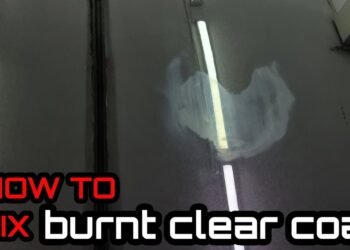Cleaning a fuel pressure regulator is essential for maintaining engine performance. This task ensures your vehicle runs smoothly and efficiently.
A dirty fuel pressure regulator can cause many problems. From rough idling to poor fuel economy, neglecting this component can lead to bigger issues. But don’t worry, cleaning it is simpler than you might think. In this guide, we’ll walk you through the steps to clean your fuel pressure regulator effectively.
We’ll cover the tools you need, safety tips, and the cleaning process itself. This way, you can keep your vehicle in top shape without any hassle. Let’s dive in and learn how to do it right!

Credit: www.youtube.com
Introduction To Fuel Pressure Regulators
A fuel pressure regulator is a small device with a big job. It ensures the engine gets the right amount of fuel. This keeps your car running smoothly. Let’s dive deeper into what it does and how to spot issues.
Purpose And Function
The fuel pressure regulator controls fuel pressure in the fuel injectors. It adjusts pressure to match the engine’s needs. This helps maintain optimal performance.
Here’s a simple table showing its functions:
| Function | Description |
|---|---|
| Pressure Control | Keeps fuel pressure steady |
| Fuel Efficiency | Improves fuel usage |
| Engine Performance | Ensures smooth operation |
Signs Of A Faulty Regulator
A faulty fuel pressure regulator can cause many issues. Watch for these signs:
- Engine misfires or stalls
- Black smoke from the exhaust
- Poor fuel economy
- Fuel leaks
- Strong fuel odor
If you notice any of these, it’s time to check your regulator.

Credit: fixkick.com
Preparation For Cleaning
Cleaning a fuel pressure regulator is crucial for maintaining optimal engine performance. Before diving into the cleaning process, proper preparation is essential. This section will guide you through the necessary tools, materials, and safety precautions.
Tools And Materials Needed
Gathering the right tools and materials beforehand can save time. Here is a list:
- Screwdrivers: Both flathead and Phillips
- Wrenches: Various sizes
- Cleaning Solution: Specifically for fuel systems
- Rags: Clean and lint-free
- Safety Goggles: Protect your eyes
- Gloves: Preferably nitrile or latex
- Container: To catch any fuel spills
Safety Precautions
Safety should always come first. Here are some crucial precautions:
- Work in a ventilated area: Fumes can be harmful.
- Disconnect the battery: Prevent electrical shocks.
- Wear protective gear: Goggles and gloves are a must.
- Keep a fire extinguisher: Fuel is highly flammable.
- Avoid open flames: Even a small spark can cause fire.
Following these steps ensures a safe and efficient cleaning process. Proper preparation makes the task easier and safer.
Locating The Fuel Pressure Regulator
Finding the fuel pressure regulator can be tricky. It varies by vehicle type and model. Knowing its location is the first step in cleaning it. This guide will help you identify where to find it and how to make accessing it easier.
Vehicle-specific Locations
The location of the fuel pressure regulator depends on the vehicle. In many cars, it is near the fuel injectors. Others may have it on the fuel rail. Some trucks have it close to the gas tank. Look at your vehicle’s manual. It often has a diagram showing the regulator’s position.
In older vehicles, the regulator is often in the engine bay. Newer models may have it integrated into the fuel pump. This is usually inside the gas tank. Always check specific guides for your car make and model.
Tips For Easy Access
Accessing the fuel pressure regulator can sometimes be difficult. Clear the area around it first. Remove any covers or components that block your way. Disconnect the battery. This ensures safety while working on the fuel system.
Use the right tools. A socket set and screwdrivers are usually needed. Have a clean workspace. This helps to avoid losing small parts. Wear gloves to protect your hands. Safety goggles are also a good idea.
Take your time. Rushing can lead to mistakes. Follow the steps methodically. This ensures you can clean the regulator properly without causing damage.
Removing The Fuel Pressure Regulator
Cleaning a fuel pressure regulator can improve your vehicle’s performance. The first step in this process is removing the regulator. Follow this guide to remove the fuel pressure regulator safely and correctly.
Step-by-step Removal Guide
First, disconnect the battery to avoid sparks. Next, locate the fuel pressure regulator. This part is usually near the fuel rail. Consult your vehicle’s manual for the exact location.
Use a wrench to remove the bolts holding the regulator. Keep these bolts safe for later use. Pull out the regulator carefully. Avoid damaging any surrounding parts.
Handling Fuel Safely
Fuel is flammable. Work in a well-ventilated area. Wear gloves and safety glasses. Have a fire extinguisher nearby. Ensure no open flames or sparks are present.
Drain any fuel from the system before removal. Use a container to catch the fuel. Dispose of the fuel properly. Follow local regulations for fuel disposal.
Cleaning Techniques
Keeping your fuel pressure regulator clean is vital. It ensures your engine runs smoothly. Proper cleaning can improve performance and fuel efficiency. There are various cleaning techniques to consider. Each has its own set of tools and steps.
Using Cleaning Solutions
Cleaning solutions are effective. They break down grime and deposits. Use a specialized cleaner for fuel systems. First, disconnect the regulator. Spray the cleaner directly onto the regulator. Let it sit for a few minutes. This helps loosen dirt and residue. Wipe it clean with a cloth. Make sure to follow the cleaner’s instructions. Always wear gloves to protect your hands.
Manual Cleaning Methods
Manual cleaning requires basic tools. A brush and some elbow grease work wonders. Use a small brush with stiff bristles. Scrub the regulator gently. Focus on areas with visible dirt. A toothbrush can reach small spaces. Avoid using too much force. It can damage the regulator. Rinse with water if necessary. Dry it completely before reinstallation.
Inspecting For Damage
Keeping your fuel pressure regulator in good shape is essential. A damaged regulator can cause engine problems. It’s important to inspect it regularly. This section will guide you through the process.
Visual Inspection Tips
Start with a visual check. Look for any obvious signs of wear and tear. Cracks or leaks are easy to spot. Rust or corrosion can also signal trouble.
- Check the body for cracks.
- Look for any fuel leaks.
- Inspect for rust or corrosion.
- Ensure all connections are secure.
When To Replace
Sometimes, a visual inspection is not enough. Certain signs indicate it’s time to replace the regulator.
| Sign | Description |
|---|---|
| Poor Engine Performance | Engine runs rough or stalls. |
| Fuel Smell | Strong fuel smell around the engine. |
| Check Engine Light | Dashboard light is on. |
| Low Fuel Pressure | Fuel pressure below the required level. |
Reinstalling The Fuel Pressure Regulator
Cleaning the fuel pressure regulator involves removing it from the engine, cleaning it with a suitable cleaner, and reinstalling it. Ensure all connections are secure before testing the engine.
Reinstalling the fuel pressure regulator is a crucial step. This ensures your vehicle runs smoothly. You need to follow the correct steps. This prevents any potential issues.Proper Reinstallation Steps
First, align the regulator with its mounting spot. Make sure it fits perfectly. Then, gently insert it into place. Avoid using excessive force. Next, secure the regulator with bolts. Tighten them evenly. Use a torque wrench if available. This ensures the bolts are not too tight or too loose. Reconnect the fuel lines. Ensure each connection is firm. Double-check for any leaks.Ensuring A Secure Fit
A secure fit is essential. Double-check the bolts. They should be tight but not over-torqued. Inspect the O-rings. They should be in good condition. Replace any damaged O-rings. Reconnect the electrical connectors. Ensure they click into place. Test the system. Start the engine. Listen for any unusual sounds. Check for leaks around the regulator. Following these steps ensures your fuel pressure regulator works properly. “`Credit: www.ausrotary.com
Testing The Regulator
After cleaning your fuel pressure regulator, you need to test it. This ensures that it works properly. Below, you will learn how to check for leaks and verify proper function.
Checking For Leaks
Leaks in the fuel pressure regulator can cause serious issues. Follow these steps to check for leaks:
- Start the engine and let it idle.
- Inspect the regulator and surrounding area for fuel leaks.
- Use a clean cloth to wipe around the regulator.
- Observe if any new fuel appears on the cloth.
If you see any fuel, the regulator might be damaged. Consider replacing it.
Verifying Proper Function
Next, verify if the regulator functions correctly. Use a fuel pressure gauge for this test:
- Attach the fuel pressure gauge to the test port.
- Start the engine and let it idle.
- Note the pressure reading on the gauge.
- Compare the reading with the manufacturer’s specifications.
If the pressure is too high or too low, the regulator might be faulty. Consider further inspection or replacement.
By following these steps, you can ensure your fuel pressure regulator is in good condition. This helps maintain your vehicle’s performance and safety.
Maintenance Tips
Maintaining your fuel pressure regulator in top condition is crucial for optimal engine performance. Proper maintenance can prevent issues and extend the life of your regulator. Follow these maintenance tips to keep your fuel pressure regulator working efficiently.
Regular Inspection Schedule
Establishing a regular inspection schedule is essential. Check the regulator every 5,000 miles or during routine oil changes.
During inspections, look for signs of wear or damage. Pay attention to the following:
- Leaks around the regulator
- Corrosion on connections
- Clogged or dirty filters
Use a flashlight to inspect hard-to-see areas. If you notice any issues, address them immediately to prevent further damage.
Prolonging Regulator Life
To prolong your regulator’s life, follow these simple steps:
- Use high-quality fuel to minimize contaminants.
- Replace fuel filters regularly to ensure clean fuel.
- Perform routine cleaning of the regulator.
For cleaning, disconnect the regulator from the fuel system. Use a soft brush and mild cleaner to remove dirt and debris. Avoid harsh chemicals that can damage the regulator.
Keeping your fuel system clean and well-maintained will help extend the life of your fuel pressure regulator. Regular care can save you from costly repairs in the future.
Frequently Asked Questions
What Tools Do I Need To Clean A Fuel Pressure Regulator?
You need a wrench, clean cloth, and fuel system cleaner.
How Often Should I Clean My Fuel Pressure Regulator?
Clean it every 20,000 to 30,000 miles. It keeps your engine running smoothly.
Can A Dirty Fuel Pressure Regulator Cause Engine Problems?
Yes, it can cause poor engine performance and reduced fuel efficiency.
What Are The Signs Of A Dirty Fuel Pressure Regulator?
Signs include engine misfires, poor fuel economy, and rough idling.
Is It Hard To Clean A Fuel Pressure Regulator Myself?
No, it’s fairly easy. Follow the steps and take safety precautions.
Conclusion
Regular cleaning of your fuel pressure regulator ensures optimal engine performance. Follow the steps mentioned to keep it in good condition. Doing this task yourself saves money and prevents potential damage. Clean the regulator periodically to avoid fuel system issues.
A well-maintained regulator contributes to better fuel efficiency. Regular checks and cleanings go a long way. Keep your vehicle running smoothly by maintaining this small, yet crucial, component. Always use the right tools and materials. Your engine will thank you for it! Enjoy a smoother ride and longer engine life with these simple steps.

















